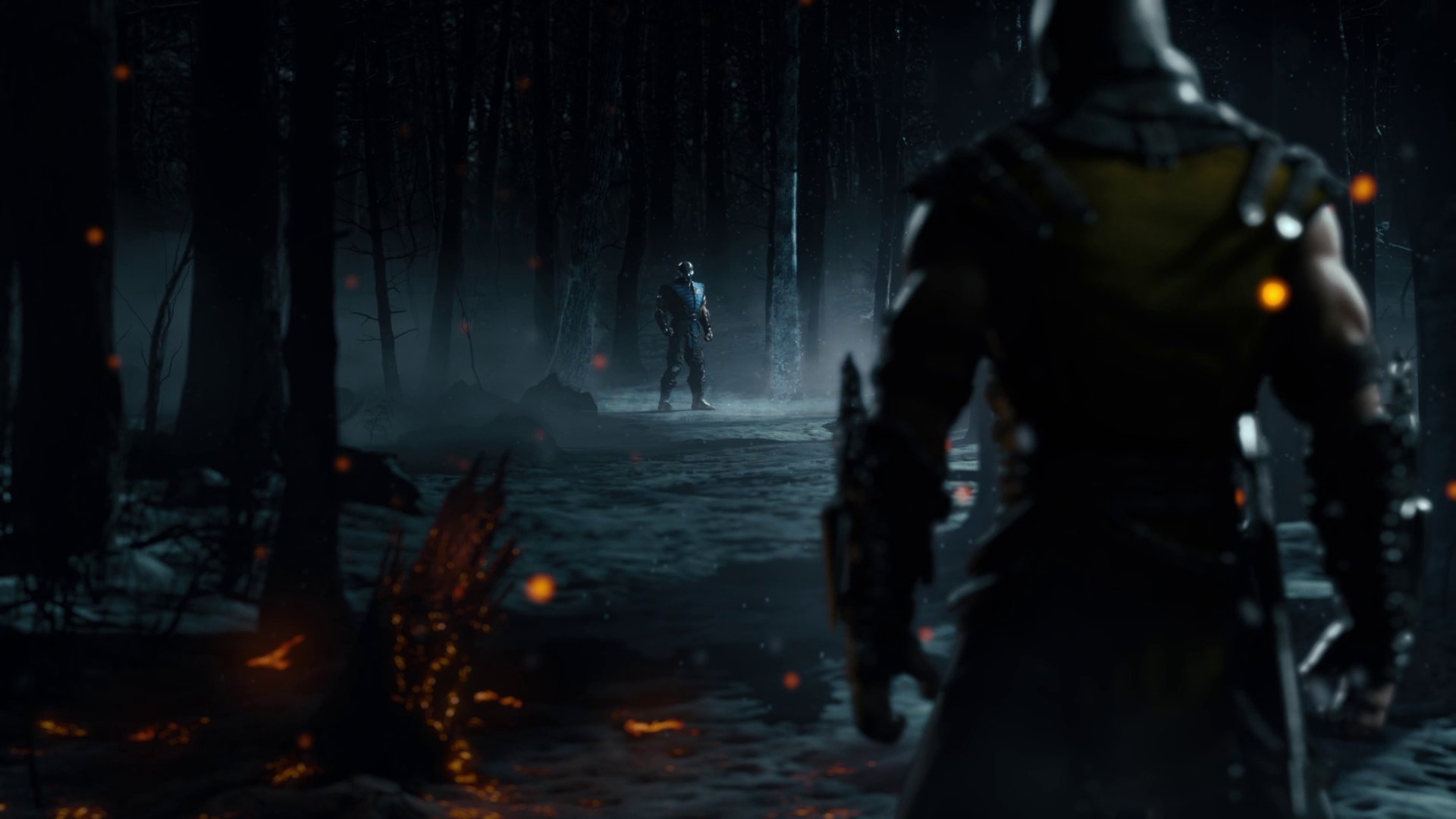Frosted 57
Reforming Lurker
Fisticuffs Guide
This is a simple Fisticuffs guide for people new to it and some tips for those who aren't.
As well as including some very basic standard Johnny Cage info.
Fisticuffs is a fairly bare bones version of Johnny Cage. You don't get any fancy mimics to use for setups, frame traps, pressure, or damage. You also don't get any fancy run cancels to use for pressure, frame traps, and hit confirming. What you do get is a new string that can be used for pressure and corner combos as well as a temporary chip damage buff.
Included below are all-around Cage basics, information on how Fisticuffs' specific tools work, how to deal with Fisticuffs specifically, and a combo list that while I posted it in the main combo thread I felt I should still post it in here.
Cage Basics
General info you can find elsewhere in more detail.
His pokes are all pretty good use them.
d1 is a solid poke at 8 frames and is mid. It is only -3 on block while being +17 on hit. This means if it hits you can pressure with anything you want.
d3 is his fastest poke at 7 frames and is a low. It is -9 on block and is +12 on hit. This should be used to get out of frame trap situations. Due to how negative d3 is on block, d1 is usually better to use as a check. When d3 hits it keeps them close making it so you can pressure with 11 or b12 without having to move.
d4 is 11 frames and is a low. It is -6 on block and is +22 on hit. This is one of the most important things in his move list. Since he lacks a low starter this low poke is how you can condition your opponents to block low which will open them up to his overhead. The main use of this move lies in its' ability to lower Cages hurtbox greatly. This allows him to avoid many normals, strings, jump ins and mid projectiles. It can fairly easily be used to counter poke against your opponents' forward advancing strings. This move causes the opponent to stagger back on hit. This means you must advance by running or walking in order to continue pressure. This is usually a good thing because what it does is push the opponent back closer to the corner while allowing you to continue pressure.
Strings
11 is 9 frames and can be used for mix-ups. Examples include 11 F24, 11 Throw, 11 Sweep, 11 d4, 11 11, 11 b12, as well as completing the string with 113xxExBD3 or 114. When using 11 throw be careful, as on hit the move has enough advantage to cause the throw to whiff if done to early. However using 1 throw will work on hit, so using 1 throw can be a better option for a throw mixup.
f24 is a 15 frame advancing overhead launcher that is only -5 on block. This is his big combo starter/opener. While it being -5 on block means it ends his turn, the string can be finished with f244 which is -6 and can be used to check your opponent.
f34 is an 11 frame advancing string that is only -3 on block. This is a very good move for checking your opponent at midrange and whiff punishing. If being used as a guaranteed whiff punish it can either be cancelled into Nut Punch or spend a bar and use Ex Nut Punch for a full combo.
Be careful using
d2, his Upper-Kut, is 9 frames. It is -17 and punishable like d2's usually are. Cage's d2 is one of the weaker ones in the game. The hitbox on it is virtually all vertical and will whiff or simply lose to most jump in attacks. For the most part it will only hit characters who are directly in contact with him.
b4, his sweep is 9 frames and a low. It is -12, so it is punishable but is still a solid low check.
*Side note:Cages 12 string does STRICTLY more damage in combos than his 11 string. There is rarely a reason to ever use 11 in most juggles.
Fisticuffs' Specific Info
Speed Bag
B12 & B121 how it works and what you should know when using it.
b1 is a 10 frame mid and is his best meterless punish for moves that are -11 and don't push back. [b12-12-12-12xxBD3 = 19%]
When your opponent gets hit by this string b1 can only be combo'd from 4 times while grounded. What this means is that if your opponent gets hit by a 1 in the string you can do b12-12-12-12xxBD3 which is 9 hits. However if your opponent gets hit by a 2 you are able to get (b1)2-12-12-12-12xxBD3 which is 10 hits.
Every hit of Speed Bag is -3 on block.
After every 2 in this string there is a very small gap where your opponent can act. Within this gap they are able to back dash or use an armored special. So if you stagger this string using a b1 or b121 you can throw off a player that is aware of this gap.(More on Staggers in the next section)
When this string is being blocked the opponent will get pushed out. Every 2 after the first causes a set amount of pushback.
Ex: b12-1(2)-1(2)-1(2)
Every (2) causes pushback. Generally all characters will be pushed out of range of Speed Bag after 4-6 hits.
A way to prevent this is by staggering the string. B1 advances slightly so if you were, for example, to instead of using b12-12-12-12 use b12, b12, b12 you would remain in range. So varying your actions become very important.
Something to be aware of is that while the hits of Speed Bag are all -3 on block they do have different recoveries. Each 1 recovers in 9 frames while each 2 recovers in 11 frames.
Also each blocked hit of Speed Bag generates about 6.5% of a bar of meter. This means it takes 16 blocked hits of Speed Bag punches to build 1 bar of meter.
Staggers
A lot of characters in MKX can pressure opponents by staggering their strings. This means ending them at different points to make your opponent have to guess or react to when they can press a button. The information below is something you can read over and over but there is no substitute for practice. Correctly timing string staggers can and likely will take practice to get down. The information here is touched on at other points in this guide, but here I have given it more detail for those less versed in the idea of staggers or how to use them as Cage.
Basic Cage staggers, simple ones which exist across every variation, mostly use 11 and to some extent 12 as an instigator. These two strings have extremely fast recovery frames which means that it will be very difficult or impossible for your opponent to react to the fact that you stopped your string early. As stated in Cage Basics above simple staggers from these would generally be 11 11, 11 f24, 11 d4, 113xxSpecial, 11 sweep, 11 throw, 114, or even 11 block if you believe your opponent wants to do an unsafe reversal. Another string to stagger is f244. F24 is Johnny's safe overhead launcher which is -5. If you complete the string it is -6, which is still safe. If your opponent realizes that you aren't finishing the string they will likely try to poke or pressure you. At this point it can be worth it to complete the f244 string on block to force them to respect the fact that you can. You can often catch players with that last hit if they haven't seen you do it often.
Fisticuffs has a unique tool in his Speed Bag string which allows him to stagger strings in different and often more reactionary ways. While mashing b121 can get you far playing against some less experienced players it is unwise to just do that against someone who knows anything about the matchup. Staggering b121 is interesting because you can stop the string and start it up again at any point and it is not easy to react to. One of the simpler things you can do is start doing b12-12-12 and see how your opponent is blocking. If they are stand blocking you can stagger in a d4 or d3, if they are crouch blocking you can stagger in a f24. It is also very important to stagger in throws to show your opponent they cannot just block against b121 for free. Due to the fact that there is a gap after every 2, opponents often attempt to armor out. So if you believe they are going to attempt this you can stagger block into another stagger(for instance b1212, block for a few frames to avoid reversals, b1212). Staggering in 11's is also very effective because players often react to 11 differently than b121 because they see it as an imminent mix-up/fuzzy guard through 113 and 11 f24. However there is no reason for you to commit to the 113 or f24 often since returning to b121 after the 11 can be just as effective if your opponent is expecting something else.
Getting down what works and what doesn't for you as well as what does and what doesn't against each opponent can be very tough to get comfortable with. Personal experience and trial by fire is really the only thing I can recommend once you have gotten what you can out of training mode practice.
Fist Bump
Whats the deal with this.
BF1 is a special move that takes 40 frames to complete. This move grants Johnny a temporary buff to chip damage which lasts ~8 seconds. Normally when moves are blocked they do approximately 20% of the damage they would do if it hit. With Fist Bump active the damage of all of Johnny's attacks that are blocked are instead ~40%. This buff also increases the damage of Speed Bag, causing each hit to deal 3% (up from 2%). This also causes the chip from Speed Bag to be raised to 1.20% which is 40% of 3%. The final thing this buff does is cause his throws to deal 17% damage, which is a 5% buff.
With Fist Bump active your meter gain on block does not increase. For instance 5 reps of 214 will gain 1 meter if blocked whether Fist Bump is active or not(Fist Bump itself is a special and grants some meter on activation).
There is now ONE safe-ish way to activate Fist Bump on block. When you cancel a near max range standing 4 into Fist Bump it leaves you at about -7. The only thing that can punish this is Kung Lao's Ex Spin. However this can be pretty random, as sometimes it is blockable and others it is not.(Breathing Hitboxes?
 )
)There are two issues that come with activating this special,
1: Due to its' long activation time it is very difficult to make safe at any range. If this move is cancelled into on block it is virtually always punishable.
2: In order to effectively activate it safely you can end a combo with either f24xxBF1 or 121, BF1. This issue with doing this is that you are losing damage at the end of your combo(somewhere between 5% and 7%). You then also lose the standing reset gained from the Nut Punch ender and the chip damage and pressure that is guaranteed(which could result in as little as 3% chip or a full combo). So taking the lowest situation of 8% damage lost when using Fist Bump. You would need to have your opponent block for 16% damage to break even and make up for it since 8% of that is what would be dealt without the buff active. The throw buff helps this since a throw gains you 5%. So 2 throws will gain you more damage than the lowest situation if you ended in Nut Punch.
Now situations can arise where you could activate the buff and have it be more beneficial, however I would recommend using Nut Punch enders for the higher guaranteed damage and pressure until you believe you fully understand what you are giving up by using Fist Bump instead.
That said there are still times you can and should use Fist Bump. One being when you are full screen using projectiles, if they don't have a full screen presence or if their projectiles do relatively low damage(say 5% or less) you can activate and get hit by a projectile to end the recovery frames of Fist Bump and for the duration your Forceballs will deal 4% when blocked. In addition if your opponent is about to get breaker it could be correct to either end the combo early into Nut Punch or end it into Fist Bump to set up for them to block instead and not gain the meter needed for the breaker.
Weaknesses
This variation suffers from fairly large flaws that he either does not have or are less apparent in his other variations.
1: In this variation he has no way to safely combo from his 113 low string under any circumstances. In Stunt Double he can use up shadow for a full combo. A-list can Shadow Kick run cancel from 113 into f24 or f4 for a full combo. So against Fisticuffs you do not need to fear his low option very much.
2: His only plus frames are on 1, 11, 12, and ExDF2/Forceballs. When ExDF2 is used on block you get pushed out to a range where 1 and B1 whiff. This makes it harder for Fisticuffs to apply pressure compared to his other variations.
3: Cage across all variations has weak anti-air options. None of his options are all that consistent. The best of which is ExNut Punch. While this works often there are situations where it will still whiff. One of his best options against many (not all) characters is to use d4 to low profile their jump attacks. So as a Cage player get as comfortable as you can with his anti-air options. As an opponent make the Cage player prove that they know how to anti-air, because if they don't your jump attacks will be virtually free.
How to deal with Fisticuffs specific things. Both players options.
Speed Bag
B121...
There are no gaps in which you can poke, reversal throw or reversal special without armor. That said there is a gap after every 2 in the string.
During this gap you can use an armored special if is 13 frames or faster, a 14 frame armor reversal will trade.
In addition, outside of the corner every character can back dash during this gap. While largely safe, if the Cage player reads this they can punish most back dashes meterless with F3xxBD3 for 14% which will place the opponent back into the same situation.
Outside of taking action, you can just block. Every 2 in the string after the first causes a set amount of pushback. Against most characters somewhere between 4 and 6 hits on block is enough to push Cage out of range. However when the string is staggered it can stay within range longer, but if the string is being staggered you have a larger gap to escape. When blocking Speed Bag always be aware of his stagger options. A throw, f24 or a low poke could come at any time.
F3
This move is an 11 frame advancing normal. F3 alone is -8 on block and has 36 recovery frames. What this means is that you can just wait, and know that the F3 was not cancelled into anything, and punish if possible for your character or pressure him. If the string was finished into F34 that is -3, which makes it safe while ending his turn. When at midrange against Cage F3 is always a threat. So be aware and ready to block it. Neutral jumping can also be a good choice if you are expecting it.
Last edited:






 I'll go back to this to get my Salticuffs tech down.
I'll go back to this to get my Salticuffs tech down. Thanks again for the write-up! ^_^
Thanks again for the write-up! ^_^